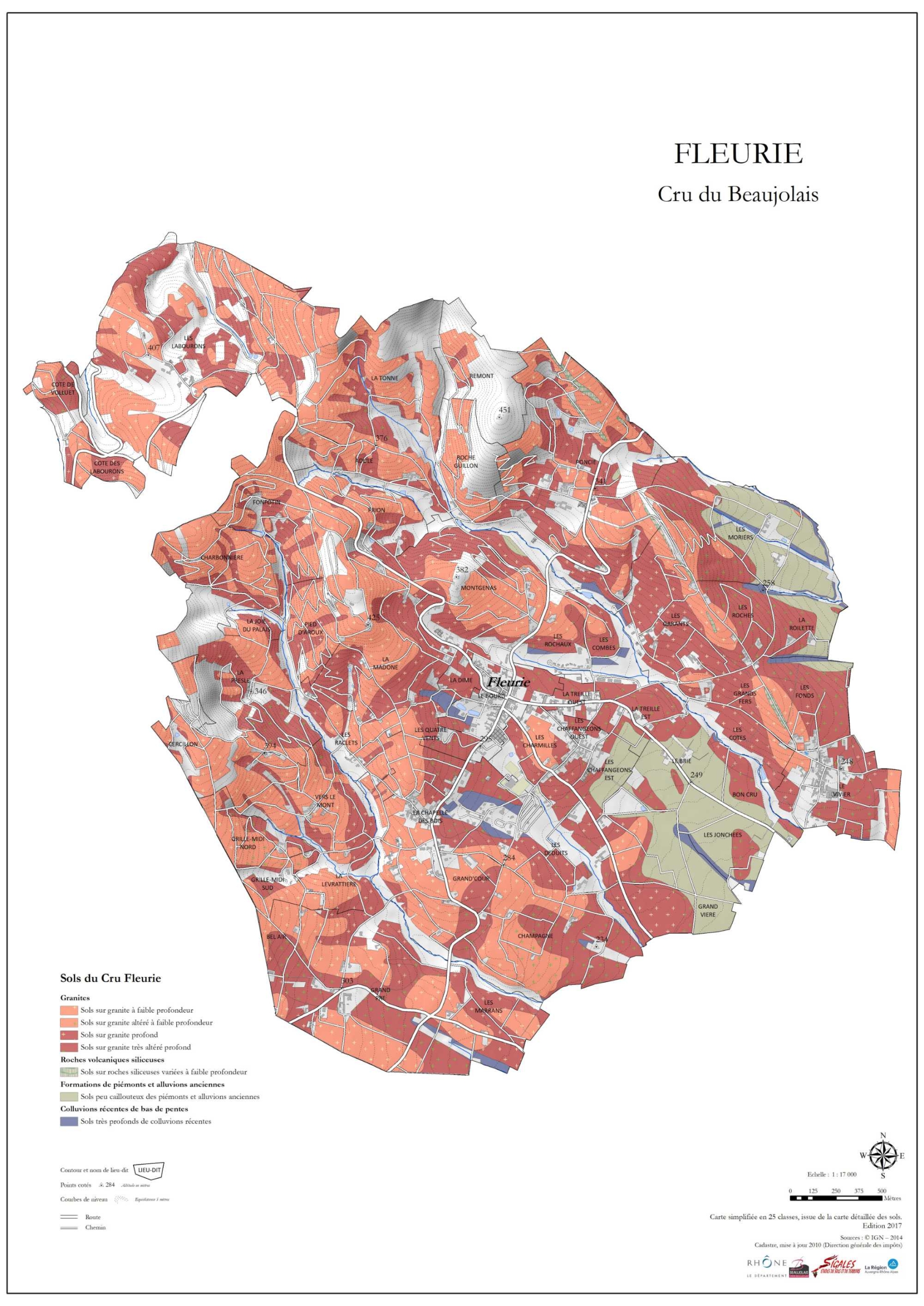Fleurie
HEAVENLY LANDSCAPES, HOME TO FRAGRANT WINES
The Fleurie appellation has the geographical particularity of sloping down from a range of peaks including the Fût d’Avenas, Col de Durbize, Col des Labourons and Pic Raymont. The hill, called La Madone, towers over the appellation, offering a breath-taking panorama of all the vineyards. Located entirely in the commune by the same name, it owes its name to a Roman legionary.
The Fleurie appellation: an overview
Les vins les plus féminins du vignoble du Beaujolais sont sans conteste les vins de Fleurie. Ils se cultivent tout d’abord dans un environnement verdoyant, au cœur de sublimes lieux-dits, pour finir par revêtir une robe rouge carmin du plus bel effet.
- CommuneFleurie
-
Lieux-dits
- La Madone
- Les Labourons
- Grille-Midi
- Les Moriers
- Les Garants
- La Presle
- La Chapelle des Bois
- Grand Pré
- La Roilette
- Champagne
- Altitude340 metres
- SoilPink granite (90%), piedmont deposits (8%)
- Surface Area840 hectares
Characteristics
of Fleurie appellation
- TastingLuminous, fruity, delicate
- Tasting occasionAperitifs, dinner with guests
- NoseIris, violet, rose, red fruit, vine peaches
- Culinary suggestions
Pork roast with apples and chestnuts, spice-crusted salmon and roasted veggies
- ColourCrimson red
- Serving temperature13-15°C
- PalateElegant, refined
Learn more
about the Fleurie appellation
HEAVENLY LANDSCAPES, HOME TO FRAGRANT WINES
Lovingly tended by 150 winegrowers, the Fleurie appellation gets its lightness from being sheltered by the Avenas, Durbize and Labourons range. The Fleurie vineyards back on to this particular massif and grow in sandy soil formed by the weathering of pink granite. It’s this very specific terroir that gives the wine its delicate, elegant robe and its floral notes, which is why it is called a “feminine wine”.
Nevertheless, Fleurie wines have very distinctive flavours and, depending on where the vines are grown, some crus are much more full-bodied than others. The iris, violet and peach notes intensify the bouquet perfectly and guarantee a fleshy structure.
Even though the name Fleurie sounds rather feminine, it has nothing to do with nature. The name would appear to come from a Roman legionary called Florus, who was said to have settled down in one of the hills overlooking the vines. However, there is no actual proof of the legend but what does that matter since legends are often more enchanting than reality…
A unique landscape for growing Fleurie wines
Perhaps a quick geology lesson is needed to mention the unique landscape where Fleurie vines grow. At the end of the Tertiary Era, exceptional tectonic and magmatic processes changed the landscape forever. The land was thrust upwards and hills formed across the Beaujolais region that were shaped over the years by erosion.
La Madone stands at the highest point of these valleys at 425 meters in altitude. The impressive statue is the landmark for the Fleurie vines, which grow from the south-eastern side of the hill and climb up to the Madone chapel.
The slopes with a 50% gradient offer outstanding views over the area where the crus are grown. It’s a great place to watch the radiant sun rise and then set over the Chiroubles vines in the west.
Delicate, elegant flavours
Fleurie wines have a certain unique softness in comparison to other Beaujolais appellations. However, it’s hard to find just one description that fits all the bottles produced in this winegrowing area.
Ninety percent of the terroir is made up of pink granite that is undergoing slow erosion. The uneven weathering, along with soils of varying depths, produces wines that are unique and different from one year to the next. It is worth nothing that on granitic soil, gamay grapes produce powerful and deeply-coloured wines.
For example, compare a wine from Roilette with one from Grille-Midi. There are considerable differences in character. Since the former grows on more granitic soil than the latter, you’ll be pleasantly surprised by its powerfulness, while you’re sure to find the Grille-midi’s fruity character appealing. The result being two wines to drink in different circumstances.
Generally speaking, the attack of a Fleurie on the palate is frank, the acidity is low and the tannins are gentle. These Beaujolais wines have nice roundness on the palate, and are just as good as aperitifs or with red or white meat. You can also stay on theme by serving them with mouth-watering Beaujolais- style andouillette sausages!
Fleurie is a great wine grown in vineyards that are great to visit! Its qualities mainly derive from its outstanding location, sheltered from the elements. The terroir also plays a role in the fruity, floral flavours… But be wary of the myth that they are always feminine wines! Not only do women like the distinguished crus but Fleurie also has a range of nuances that can give it a delicate bouquet or a full-bodied structure. The best idea is to come and taste it right on site while enjoying the Beaujolais region’s lush natural settings.



